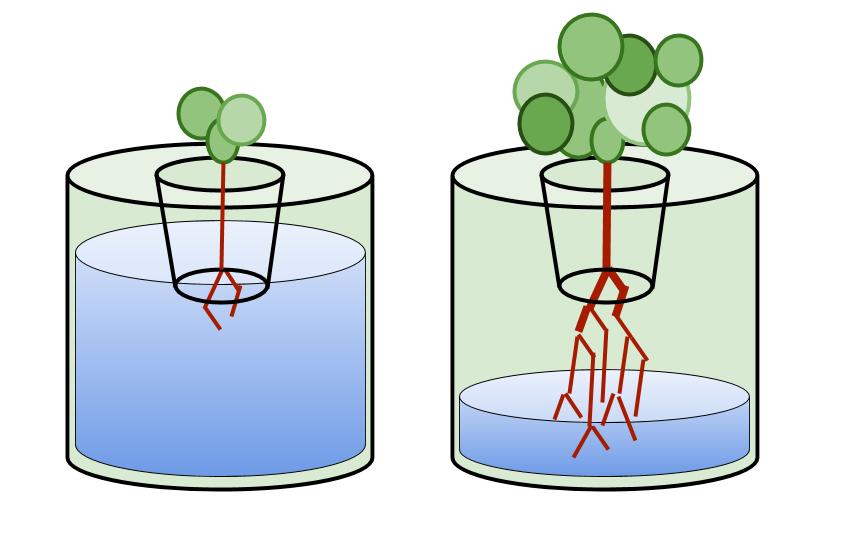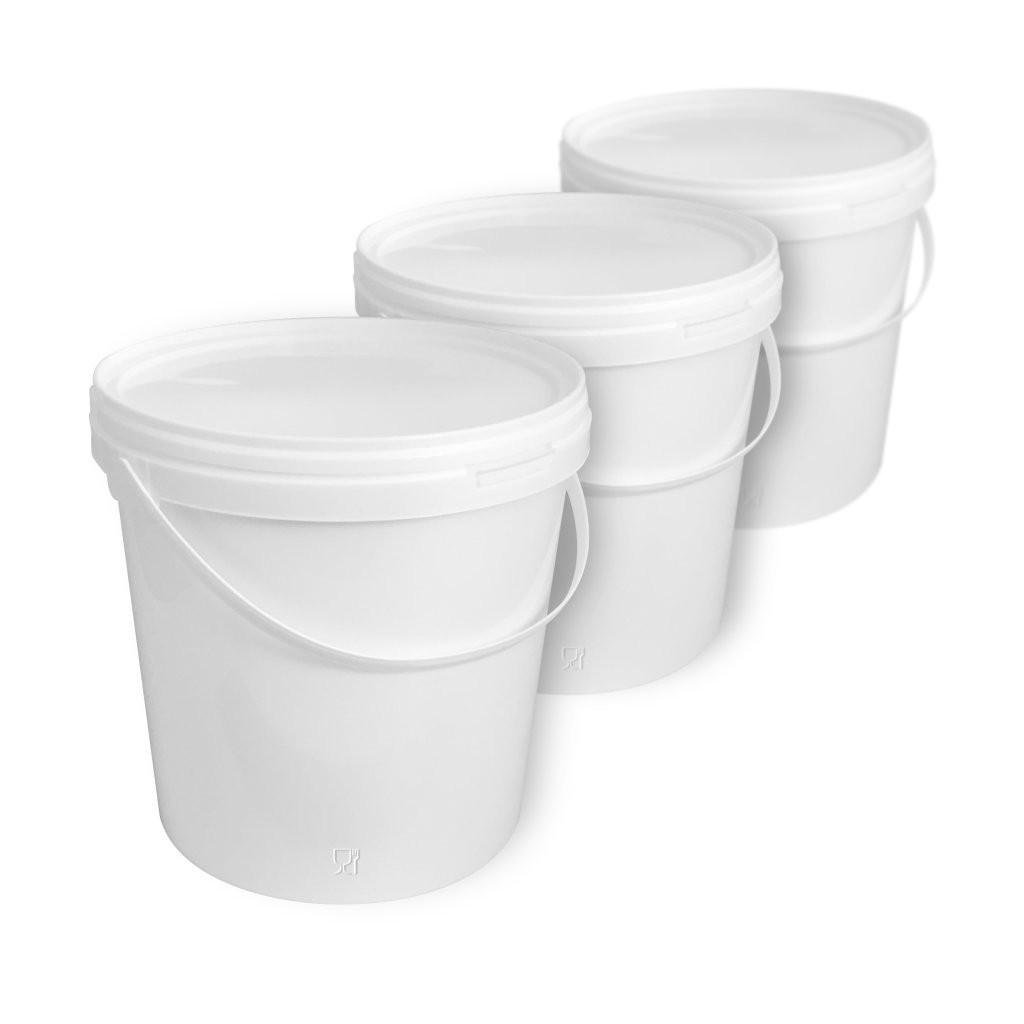It sounds almost too good to be true: Planting without having to worry about it, growing plants without watering, and you don’t even need soil. What you need for this and how the whole thing works we explain to you in this article.
What is the Kratky Method?
Indoor and outdoor gardening enthusiasts are always looking for new ways to grow healthy and abundant plants, and the Kratky Method is one technique that’s gaining popularity. This innovative approach to hydroponic gardening (Hydroculture) requires no electricity, no pumps, and no timers, making it an excellent choice for anyone who wants to grow plants in a low-maintenance and cost-effective way.
The Kratky Method is a passive hydroponic system that relies on the principle of water level fluctuation. It involves growing plants in containers filled with an inert growing medium, such as perlite or vermiculite, and providing them with a nutrient solution. The plants absorb the nutrient solution through the growing medium, and the water level in the container drops as the plants grow and use up the nutrients. This creates an air gap between the surface of the nutrient solution and the bottom of the growing medium, which allows the roots to access oxygen. As a result, the Kratky Method can produce healthy and thriving plants without the need for any additional equipment or electricity.
Maximizing Small Indoor Spaces with the Kratky Method.
Using the Kratky method for small indoor spaces can be a breakthrough for those who have limited room to grow plants. This hydroponic technique doesn’t require electricity, pumps, or fancy equipment, making it an affordable and practical solution for small-space gardening.
The Kratky method is a passive hydroponic technique that allows plants to grow in a container without any air or water pumps. Instead, the plants grow in a non-circulating nutrient solution, which provides them with the necessary nutrients to thrive. This method is perfect for indoor gardening as it doesn’t require any electricity, making it an ideal choice for those who want to grow herbs and vegetables in a small apartment or on a windowsill.
With the Kratky method, you can grow a wide variety of plants indoors, including herbs, lettuce, tomatoes, and peppers. This hydroponic method is simple and straightforward, making it an excellent choice for beginners who want to try their hand at indoor gardening. Plus, the lack of pumps and electricity makes it an eco-friendly choice that won’t increase your energy bill.

Setting up a Kratky system for indoor herbs and vegetables
Setting up a Kratky system for indoor herbs and vegetables is a great way to enjoy fresh produce year-round. The Kratky method is particularly well-suited for small indoor spaces, as it requires minimal maintenance and doesn’t rely on electricity or pumps.
To set up a Kratky system for indoor gardening, start by selecting the right container for your plants. You can use any type of container as long as it’s watertight and has a lid. Mason jars, plastic containers, and recycled bottles are all great options. Once you have your container, add a nutrient-rich solution to the bottom and place your plant in the net cup on top. Finally, cover the container with a lid to create a closed environment for your plant to thrive in.
With a Kratky system, you can grow a variety of herbs and vegetables indoors, including basil, lettuce, and spinach. The best part is that you don’t need any previous gardening experience to get started. Just make sure to monitor the water level in your container and add more nutrient solution as needed. With a little patience and care, you’ll soon be enjoying a bountiful harvest of fresh, homegrown produce.
Choosing the right container for your indoor Kratky system
Choosing the right container is crucial for setting up an effective indoor Kratky system. The container must be large enough to accommodate the plant and the nutrient solution, while also allowing for adequate air circulation around the plant. A popular option for indoor Kratky gardening is the use of Mason jars, which come in various sizes and can be easily found at local stores or online. Alternatively, you can opt for plastic containers that are specifically designed for hydroponic gardening, like the bucket with lid.
When selecting a container, it’s important to consider the size and type of plant you want to grow. Leafy greens, herbs, and smaller vegetables like cherry tomatoes and peppers can thrive in smaller containers, while larger plants like cucumbers and zucchini will require larger ones. Transparent containers are ideal for monitoring the water level and nutrient solution. Regardless of the container you choose, make sure it has a lid or cover to prevent evaporation and keep out debris.
How does planting with the Kratky method work?

The Kratky method is a hydroponic system that allows plants to grow without the use of electricity or pumps, making it a simple and cost-effective way to cultivate a variety of herbs and vegetables. Here’s how it works:
- Start by selecting a container: The first step to planting with the Kratky method is to select the right container for your plants. The container needs to be large enough to hold water and your plants, but not so large that it is difficult to move around.
- Add nutrients to the water: Once you have your container, you need to add the right amount of nutrients to the water. This will provide the plants with the necessary minerals to grow and thrive. You can use pre-mixed nutrient solutions or mix your own.
- Plant your seedlings: Once your nutrient solution is ready, it’s time to plant your seedlings. You can start by planting small seedlings in net cups or directly in the nutrient solution. Make sure that the roots are fully submerged in the solution.
- Cover the container: Once your plants are in place, cover the container to create a humid environment. This will help to prevent evaporation and keep the water level consistent.
- Monitor water levels: As the plants grow, they will start to consume water and nutrients. It’s important to monitor the water levels regularly and add more nutrient solution as needed.
- Wait for the harvest: With the Kratky method, you don’t need to worry about pumps or electricity. Simply wait for your plants to grow and harvest them when they are ready.
Using the Kratky method is a simple and efficient way to grow plants without the need for a complicated irrigation system. With a little bit of planning and the right container, you can have a successful harvest of fresh herbs and vegetables in no time.
How to use the Kratky method for outdoor gardening
The Kratky method is perfect for outdoor gardening because it allows you to grow plants in small spaces or challenging environments with minimal maintenance. To use the Kratky method for outdoor gardening, you’ll need some basic supplies such as a container, growing medium, and nutrient solution. This method works on the principle of passive hydroponics where plants grow in a container filled with a growing medium, such as coconut coir or perlite. The container should be large enough to accommodate the plant’s root system and deep enough to hold a sufficient amount of nutrient solution.
Once you have chosen the right container and growing medium, it’s time to add the nutrient solution. Make sure that the nutrient solution is at the right level, and there is no excess water in the container. Excess water can lead to root rot and other plant diseases. After adding the nutrient solution, you can then add the plant seedlings or cuttings.
Using the Kratky method for outdoor gardening is a great way to grow plants with minimal effort while maximizing yields. With the right supplies and techniques, you can grow a wide variety of plants using this hydroponic method.
Choosing the right location for your outdoor Kratky system
Are you planning to set up an outdoor Kratky system, but not sure where to place it? Here are a few steps to help you choose the right location:
- Look for a spot with plenty of sunlight: Most plants require at least six hours of sunlight per day to thrive, so choose a location that gets enough sunlight throughout the day.
- Consider the wind: Wind can help plants grow strong, but too much wind can damage your plants or even knock over your Kratky container. Choose a spot that’s sheltered from strong winds.
- Check the drainage: Since the Kratky method relies on a standing water system, it’s important to make sure that your chosen location doesn’t have drainage issues. Avoid areas that are prone to flooding or standing water.
- Measure a level surface: The Kratky container needs to be level to ensure that the water level remains consistent. Look for a flat, stable surface that can support the weight of the container.
- Accessibility: Make sure you can easily access your Kratky system for maintenance and harvesting. Choose a location that’s convenient for you to tend to your plants.
By following these steps, you can find the perfect location for your outdoor Kratky system and ensure that your plants thrive.
Closing Thoughts
In conclusion, the Kratky Method is an excellent solution for indoor and outdoor gardening enthusiasts who want to grow plants and vegetables without the need for soil or traditional watering methods. By following the steps outlined in this article, you can set up your own Kratky system and start growing your favorite herbs and vegetables.
Whether you have limited space or simply want to try something new, the Kratky Method offers a simple and effective way to grow plants at home. For more tips on gardening and hydroponics, be sure to check out our other articles, such as Mastering the Art of Happy and Healthy Garden Containers: Tips for Preventing Waterlogging Woes and Hydroculture vs Hydroponics: Which Method is Right for You?






4 comments